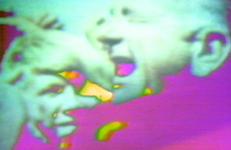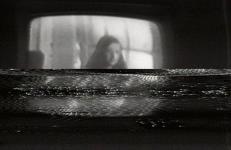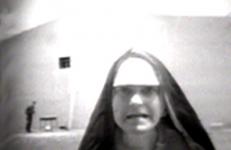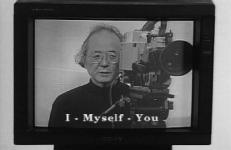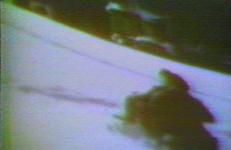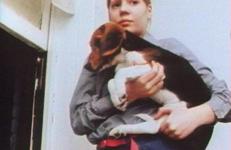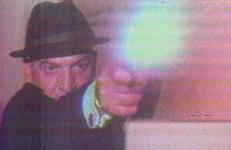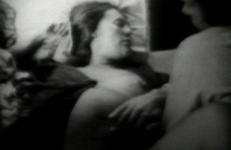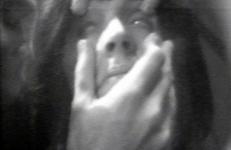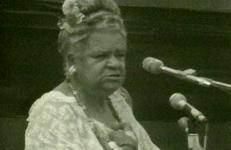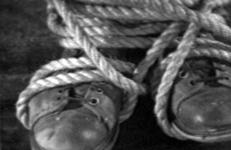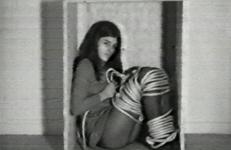Skip Blumberg of the Videofreex conducts an interview with Charles “Cappy” Pinderhughes, the Lieutenant of Information of the New Haven branch of the Black Panther Party. From the steps of the New Haven headquarters, Cappy publicizes the upcoming Revolutionary Peoples Constitutional Convention set to take place in Washington, D.C. later that week (June 19th, 1970). In addition, Cappy provides a statement to be shared via the Videofreex at the Alternative Media Conference occurring at Godard College in Vermont.
Video History
In a tape that stands out as one of the earliest examples of the use of appropriated television footage, Freed assembles a collage of images representing American media icons, from Mickey Mouse and Richard Nixon, to The Wizard of Oz and the Rolling Stones. Placing cartoon images next to images of the war in Vietnam, Freed creates an appropriately surreal vision of American culture, and begs the question whether an anthropologist of the future would be able to decipher the truth of the age from such a confused mix of representations.
The earliest of Benglis's videoworks, Noise calls attention to the assemblage element of video by allowing the image to disintegrate into static between edits. Benglis also plays back several generations of image and soundtrack to introduce increasing amounts of distortion. Conversation is reduced to unintelligible noise, resulting in the disassociation of sound and image that to some extent characterizes her later work.
This title was in the original Castelli-Sonnabend video art collection.
Throughout the video, Benglis asks "Now?" and "Do you wish to direct me?" and repeats commands like "Start the camera" and "I said start recording." As in On Screen, she makes faces and sounds in reply to the images on a monitor; at one point she appears to kiss herself. The word "now", used as both question and command, focuses attention on the deceptive "real" time of video, and reveals the structure underlying her presence in the video.
A classic example of feminist performance videos of the 1970s, which often incorporated autobiography, expansion of self through personae, and assertions of a new identity for women. In Nun and Deviant the performers come to happier terms with their identities both as women and as artists.
A classic example of feminist performance videos of the 1970s, which often incorporated autobiography, expansion of self through personae, and assertions of a new identity for women. In Nun and Deviant the performers come to happier terms with their identities both as women and as artists.
This video trilogy of Camera, Monitor, Frame, Observer / Observed, and Observer / Observed / Observer creates a semiology of video as a work on video rather than a written text. Its main purpose is to study the structural relationships between video and language, in this case using the English language. I designed a system depicting the relationship between the observer and the person being observed using words such as "I" and "YOU" through a video feedback system as the basis. This trilogy is a remake of my 1975-76 piece. It is shorter in
"Benglis manipulates generations of video footage to confound our sense of time; she implies an infinite regression of time and space — Benglis making faces in front of a monitor of her making faces in front of a monitor of her... ad infinitum. The viewer retains a sense of the images sequentiality, although the sequence of creation is not revealed in a logical, orderly fashion, and is heavily obscured by the random layering and continual repetition of aural and visual components."
On Subjectivity examines how information is disseminated, how people read, screen, and interpret images; how mechanisms function and articulate information. How are we affected by what the networks choose to give us, and how do we choose to interpret what we see? Considering diverse interpretations influenced by cultural difference, levels of perception, and the manipulation of the image, Muntadas provokes inquiry into the potential of television and consideration of the intentional and unintentional influence of television on our daily lives.
Starting with an activity as basic as four hands clapping, Landry composes an arresting visual documentation of the fundamentals of music through a play of visual and sonic rhythms. Landry considers these movements “imaginary hand exercises for beginning drummers.” As disembodied hands swim through shallow space, a strobe light freezes them in the process of clapping, creating a mesmerizing play of eye-ear coordination.
This title was part of the original Castelli-Sonnabend video art collection.
Acconci's open mouth is framed by the camera in an extreme close-up, bringing the viewer uncomfortably close. A desperate sense of strained urgency comes across as Acconci gasps, "I'll accept you, I won't shut down, I won't shut you out.... Im open to you, I'm open to everything.... This is not a trap, we can go inside, yes, come inside...." Acconci continues to plead in this way for the length of the tape, his mouth held unnaturally wide open. The pathological psychology of such enforced openness betrays a desperate struggle to accept and be accepted by others.
The four‐part cycle Parallel deals with the image genre of computer animation. The series focuses on the construction, visual landscape and inherent rules of computer-animated worlds.
“Computer animations are currently becoming a general model, surpassing film. In films, there is the wind that blows and the wind that is produced by a wind machine. Computer images do not have two kinds of wind.”
-- Harun Farocki
Passage To The North is a companion film to Plowman's Lunch. It is set in the same location as Altered To Suit, and some of the players appear for a second or third time—Coosje van Bruggan and Kirsten Vibeke Thueson were in A Second Quarter; Thueson and Michael Shamberg were in Altered To Suit. Although there does not seem to be a relationship between the roles each has played from movie to movie, there are some similarities in the situations these characters find themselves in.
A satire of the political television spot, Perfect Leader shows that ideology is the product and power is the payoff. The process of political imagemaking and the marketing of a candidate is revealed, as an omnipotent computer manufactures the perfect candidate, offering up three political types: Mr. Nice Guy, an evangelist, and an Orwellian Big Brother. Behind the candidates, symbols of political promises quickly degenerate into icons of oppression and nuclear war.
Plowman's Lunch is called a documentary because its intent was to explore actual occurrences—be these the building of the work, or what befalls the players. It still uses an open form, but the characters are more developed; they have "names," and some of the scenes were truly dangerous for them to produce. As in the other films (with the exception of Done To) there is a nucleus of three characters—two women (Boris and Jamiee), and one man (Steentje, a tranvestite/hermaphrodite). The music, composed expressly for the piece, is harmonious with its developments.
Poison Ivy is an energetic activist response to conservative ideologies and their ‘Contract On America’.
The "cross-over" in Olympic Women Speed Skating is juxtaposed against General Hospital's whites in reverse angle shots. A couple tries disparagingly to reach an understanding. Skaters continuously return to the starting line. Frustration and exertion combine with originally scored soundtracks of disco, rock, and jazz.
Pop-Pop Video: Kojak/Wang takes a shootout from Kojak and extends the shot and counter-shot into a potentially endless battle. In the original TV fragment, images, gestures and actions rebound off one another like the echoes of repeated bursts of gunfire. Birnbaum compares gunfire with the beams of laser light from a computer in a Wang commercial, connecting destruction and violence with the products of advancing technology.
Over grainy, black and white images of a woman giving birth, Montano reads the story of a nun’s sexual self-discovery—recounting Sister Joan’s growing awareness of her body’s sensuousness and sexuality. Primal Scenes is an excellent example of women’s erotica, focusing on a woman’s experience of her body as both sexually powerful and deeply mysterious.
This extraordinary performance carries a wealth of associative meanings in the sexual dynamics of privacy and power -- man and woman pitted against each other in a struggle for mental and physical control.
"In Pryings, one of his earliest and least verbal tapes, the artist is seen trying to force open and gain entry into any and all of the orifices of a woman's face. His persistence outlasts the running time of the tape, as does the persistence of the woman under attack, who manages to persevere in her attempt to guard her metaphysical privacy."
Capitalizing on the visual aspect of musical performance, Quad Suite explores the essential link between the image of music and its sound. In Six Vibrations, the camera is riveted to a close-up of the four upper frets of Landry’s guitar, maintaining an image of the sound easily identified with the gridded field paintings of Agnes Martin. In Hebe’s Grande Bois, Landry improvises on a bamboo flute as the camera frames his mouth, again in extreme close-up, in the center of the screen. There is something sensual, almost obscene, about Landry’s lips.
Two years after the riots and deaths at Attica, New York, a community day was organized at Greenhaven, a federal prison in Connecticut. Think Tank, a prisoners' group, coordinated efforts with African-American community members outside the prison walls to fight racism and poverty. The event was documented by People's Communication Network, a community video group founded by Bill Stephens, for cablecast in New York City, marking the first time an alternative video collective was allowed to document an event inside prison walls.
The Red Tapes is a three-part epic that features the diary musings of a committed outsider: revolutionary, prisoner, artist. The series offers a fragmented mythic narrative and a poetic reassessment of the radical social and aesthetic aspirations of the previous decade. Acconci maps a “topography of the self,” constructing scenes that suggest both the intimate video space of close-up and the panoramic landscape of film space.
Two performers, Acconci and a young woman, occupy two wooden boxes in separate rooms, connected via monitor, camera, and microphone. The situation is symbolic of a vicarious and distended power relation, a relationship built through and reliant upon technological mediation. Watching her on a monitor, Acconci coaches the woman through tying herself up, urging her to pretend he is winding the rope around her legs and neck.
In a piece commissioned by Remy Martin, Birnbaum adopts the language of commercial advertising, using the body, gestures, and glances of a heavily made-up woman to create a scene of glamour and romance—while slipping in a disparaging narrative that touches on the actual use and abuse of Remy Martin's product. Birnbaum sets up a typical commercial, then allows the fictive narrative to intrude, upsetting the advertised fantasy with a dose of unpleasant reality.





